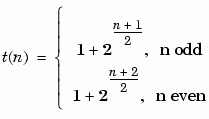

| Communications Blockset |   |
Generate a Gold sequence from a set of sequences
Library
Sequence Generators sublibrary of Comm Sources
Description
The Gold Sequence Generator block generates a Gold sequence. Gold sequences form a large class of sequences that have good periodic cross-correlation properties.
The Gold sequences are defined using a specified pair of sequences u and v, of period N = 2n - 1, called a preferred pair, as defined in the following section, Preferred Pairs of Sequences. The set G(u, v) of Gold sequences is defined by
where T represents the operator that shifts vectors cyclically to the left by one place, and  represents addition modulo 2. Note that
represents addition modulo 2. Note that  contains
contains
N + 2 sequences of period N. The Gold Sequence Generator block outputs one of these sequences according to the block's parameters.
Gold sequences have the property that the cross-correlation between any two, or between shifted versions of them, takes on one of three values: -t(n), -1, or t(n) - 2, where

The Gold Sequence Generator block uses two PN Sequence Generator blocks to generate the preferred pair of sequences, and then XORs these sequences to produce the output sequence, as shown in the following diagram.
You can specify the preferred pair by the Preferred polynomial [1] and Preferred polynomial [2] parameters in the mask for the Gold Sequence Generator block. These polynomials, both of which must have degree n, describe the shift registers that the PN Sequence Generator blocks use to generate their output. For more details on how these sequences are generated, see the reference page for the PN Sequence Generator block. You can specify the preferred polynomials using either of the following formats:
0.
For example, the vectors [5 2 0] and [1 0 0 1 0 1] both represent the polynomial z5 + z2 + 1.
The following table provides a short list of preferred pairs.
The Initial states[1] and Initial states[2] parameters are vectors specifying the initial values of the registers corresponding to Preferred polynomial [1] and Preferred polynomial [2], respectively. These parameters must satisfy these criteria:
The Sequence index parameter specifies which sequence in the set G(u, v) of Gold sequences the block outputs. The range of Sequence index is
 . The correspondence between Sequence index and the output sequence is given in the following table.
. The correspondence between Sequence index and the output sequence is given in the following table.
| Sequence Index |
Output Sequence |
| -2 |
u |
| -1 |
v |
| 0 |
 |
| 1 |
 |
| 2 |
 |
 |
 |
 |
 |
You can shift the starting point of the Gold sequence with the Shift parameter, which is an integer representing the length of the shift.
You can use an external signal to reset the values of the internal shift register to the initial state by selecting the Reset on nonzero input check box. This creates an input port for the external signal in the Gold Sequence Generator block. The way the block resets the internal shift register depends on whether its output signal and the reset signal are sample-based or frame-based. The following example demonstrates the possible alternatives. See Example: Resetting a Signal for an example.
Preferred Pairs of Sequences
The requirements for a pair of sequences u, v of period  to be a preferred pair are as follows:
to be a preferred pair are as follows:
Dialog Box
See Also
Kasami Sequence Generator, PN Sequence Generator
References
[1] Proakis, John G., Digital Communications, Third edition, New York, McGraw Hill, 1995.
[2] Gold, R., "Maximal Recursive Sequences with 3-valued Recursive Cross-Correlation Functions," IEEE Trans. Infor. Theory, Jan., 1968, pp. 154-156.
[3] Gold, R., "Optimal Binary Sequences for Spread Spectrum Multiplexing, IEEE Trans. Infor. Theory, Oct., 1967, pp. 619-621.
[4] Sarwate, D.V., and M.B. Pursley, "Crosscorrelation Properties of Pseudorandom and Related Sequences," Proc. IEEE, Vol. 68, No. 5, May, 1980, pp. 583-619.
 | GMSK Modulator Passband | Hadamard Code Generator |  |